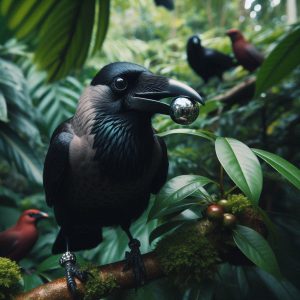Intelligence of Birds: Exploring Avian Cognition
Birds are often underestimated in terms of intelligence, but many species exhibit remarkable cognitive abilities. Understanding avian intelligence provides insights into their behavior, social interactions, and survival strategies.
Intelligence of Birds
Intelligence of Birds
Understanding the intelligence of birds helps us appreciate their complex behaviors and the evolutionary adaptations that have enabled their survival. Studies on bird intelligence contribute to broader knowledge in fields such as neuroscience, animal behavior, and evolutionary biology. To delve deeper into the intelligence of birds, visit the focused keyword URL on Intelligence of Birds.
Table of Bird Intelligence Traits
| Bird Species | Key Intelligence Traits | Examples |
|---|---|---|
| Parrots | Vocal learning, problem-solving | African Grey Parrot, Amazon Parrot |
| Crows | Tool use, memory, social learning | New Caledonian Crow, American Crow |
| Owls | Hunting skills, spatial memory | Barn Owl, Great Horned Owl |
Tool Use and Problem Solving
Several bird species have demonstrated tool use, a behavior once thought to be exclusive to primates. For instance, New Caledonian crows are known for crafting and using tools to extract insects from tree bark.
Communication Skills
Birds communicate through elaborate vocalizations and non-verbal cues. Parrots, such as African grey parrots, are famous for their ability to mimic human speech and understand complex commands.
Social Complexity
Many bird species exhibit intricate social structures and behaviors. Ravens, for example, engage in cooperative hunting and problem-solving tasks that require coordination and planning.
Birds exhibit diverse cognitive abilities, including tool use, communication skills, and social complexity.
Table: Examples of Intelligent Bird Species
| Bird Species | Intelligent Behaviors | Notable Characteristics |
|---|---|---|
| New Caledonian Crow | Tool use, problem-solving abilities | Known for crafting and using tools to obtain food. |
| African Grey Parrot | Complex vocalizations, mimicry, cognitive reasoning | Can mimic human speech and understand abstract concepts. |
| Common Raven | Problem-solving, cooperative hunting | Known for its intelligence and complex social behaviors. |
Bird intelligence continues to be a fascinating area of study, revealing surprising capabilities and challenging traditional views of animal cognition.
| Bird Species | Intelligent Behaviors | Notable Characteristics |
|---|---|---|
| New Caledonian Crow | Tool use, problem-solving abilities | Known for crafting and using tools to obtain food. |
| African Grey Parrot | Complex vocalizations, mimicry, cognitive reasoning | Can mimic human speech and understand abstract concepts. |
| Common Raven | Problem-solving, cooperative hunting | Known for its intelligence and complex social behaviors. |
Crows: Problem Solvers and Tool Users
Crows are considered some of the most intelligent birds due to their remarkable problem-solving skills and use of tools. New Caledonian crows, for instance, are known to fashion tools from leaves and twigs to extract insects from tree bark. Crows also demonstrate advanced social behaviors and can recognize individual human faces. Their intelligence extends to memory, as they can remember the locations of food caches and past experiences. Learn more about crow intelligence here.
New Caledonian Crow: Masters of Tool Use
The New Caledonian Crow (Corvus moneduloides) is a bird species native to New Caledonia, an archipelago in the South Pacific Ocean. It is renowned for its advanced problem-solving abilities and innovative tool-making skills, which are among the most sophisticated observed in non-human animals.

New Caledonian Crows are known for their exceptional tool-making and problem-solving skills.
Tool Use and Innovation
One of the most striking features of the New Caledonian Crow is its ability to create and use tools. These birds fashion tools from twigs, leaves, and other materials to extract insects from crevices or holes in trees. They exhibit a high level of dexterity and problem-solving prowess when crafting these tools, which often involve multiple steps and modifications based on the task at hand.
Scientific Studies and Research
Research on New Caledonian Crows has shed light on their cognitive abilities and evolutionary significance. Studies conducted in captivity and in the wild have demonstrated their capacity for complex problem-solving, tool innovation, and even understanding of physical properties such as water displacement.
Conservation and Habitat
While not currently listed as threatened or endangered, conservation efforts focus on preserving the habitats of New Caledonian Crows and studying their behavior to better understand their ecological role. Habitat loss and fragmentation pose potential risks to their populations, emphasizing the importance of conservation measures.
The New Caledonian Crow continues to fascinate researchers and enthusiasts alike with its intelligence and adaptability, showcasing the remarkable capabilities of avian cognition.
Parrots: Masters of Communication
Parrots are renowned for their ability to mimic human speech and sounds, which is a testament to their advanced vocal learning capabilities. Species like the African Grey Parrot are particularly famous for their impressive vocabularies and understanding of context. Parrots use their intelligence to solve puzzles, learn from their environment, and communicate with humans and other birds. For more information on parrot intelligence, visit this link.
African Grey Parrot
One of the most striking features of the African Grey Parrot is its ability to mimic human speech and other sounds with incredible accuracy. These parrots can learn a vast vocabulary and use words in appropriate contexts, demonstrating a level of understanding that is rare in the animal kingdom. Famous examples include Alex, the African Grey studied by Dr. Irene Pepperberg, who could identify colors, shapes, and quantities. For more information on Alex and his groundbreaking abilities, visit the Alex Foundation.
Problem-Solving Skills
African Grey Parrots are adept problem solvers. They can tackle complex tasks, such as unlocking cages, retrieving hidden objects, and completing puzzles designed for primates. Their problem-solving skills are not only a testament to their intelligence but also to their curiosity and need for mental stimulation. To see an African Grey Parrot in action, check out this video.
Emotional Intelligence
African Grey Parrots exhibit a high degree of emotional intelligence. They form strong bonds with their human caregivers and other birds, showing behaviors that indicate empathy and affection. They can also sense their owner’s emotions and respond accordingly, making them exceptional companions. Learn more about the emotional lives of African Grey Parrots here.
Memory and Learning
African Grey Parrots have impressive memories, allowing them to recall past events, recognize individuals, and remember training commands over long periods. This memory, combined with their ability to learn through observation and repetition, makes them highly trainable and capable of complex behaviors. For an in-depth study on their learning abilities, visit this research paper.
Social Complexity
In the wild, African Grey Parrots live in flocks, exhibiting social behaviors that require sophisticated communication and cooperation. They engage in activities such as mutual preening, food sharing, and vocal exchanges, which help maintain social bonds and group cohesion. Understanding their social structure provides insights into their cognitive complexity. Discover more about their social behaviors here.
Conservation Status
Despite their intelligence and popularity as pets, African Grey Parrots face threats from habitat loss and the illegal pet trade. They are listed as endangered by the IUCN, and conservation efforts are critical to ensure their survival in the wild. For information on conservation initiatives, visit the IUCN Red List.
Table of African Grey Parrot Intelligence Traits
| Intelligence Trait | Examples | Sources |
|---|---|---|
| Vocal Mimicry | Learning and using human words in context | Alex Foundation |
| Problem-Solving | Unlocking cages, retrieving hidden objects | YouTube |
| Emotional Intelligence | Recognizing and responding to human emotions | Psychology Today |
| Memory and Learning | Recalling events and training commands | NCBI |
| Social Complexity | Engaging in mutual preening and vocal exchanges | National Geographic |
Owls: Silent Hunters with Sharp Minds
Owls are known for their exceptional hunting skills and acute senses, which contribute to their intelligence. While not as well-studied in terms of cognitive abilities as parrots and crows, owls possess impressive spatial memory and problem-solving skills. Their ability to hunt in complete darkness using keen hearing and vision is a testament to their evolved intelligence. For more insights on owl intelligence, check out this article.
Conclusion
The study of bird intelligence reveals a world of cognitive complexity and behavioral sophistication. Parrots, crows, and owls are just a few examples of the diverse intelligence found in the avian world. Continued research in this field promises to uncover even more about the remarkable minds of birds. For further reading, explore this comprehensive study on bird cognition.
FAQs About the Intelligence of Birds
What makes birds intelligent?

Birds are considered intelligent due to their ability to solve problems, use tools, communicate complex information, and exhibit social behaviors. Certain species, such as crows, parrots, and ravens, are particularly noted for their high levels of cognitive function.
Can birds use tools?
Yes, some bird species are known to use tools. For example, New Caledonian crows use sticks to extract insects from tree bark, while certain species of parrots have been observed using objects to crack open nuts. This ability to use tools demonstrates advanced problem-solving skills.
How do birds communicate?
Birds communicate using a variety of vocalizations, body language, and visual signals. Some species, like parrots and songbirds, can mimic human speech and other sounds. Bird communication is often complex and can convey information about food sources, predators, and social interactions.
Do birds have good memories?
Many bird species have excellent memories. For example, chickadees and other caching birds can remember the locations of hundreds of hidden food stores. Parrots and crows are also known for their ability to remember human faces and recognize individual people.
What is social learning in birds?
Social learning in birds refers to the process by which birds learn behaviors from observing others. This can include learning how to use tools, solve problems, or navigate their environment. Social learning is an important aspect of bird intelligence, allowing knowledge to be passed from one generation to the next.
Disclaimer
The information provided in this FAQ section is intended for educational purposes only. While efforts have been made to ensure the accuracy of the content, it should not be used as a substitute for professional advice or scientific research. Readers are encouraged to consult authoritative sources and experts in the field of ornithology for more detailed information. I mentioned again that The information provided in this article is for educational purposes only and is not intended as a substitute for professional advice or scientific research.
Caution
When observing or interacting with birds, it is important to follow ethical guidelines and safety protocols. Respect the natural habitats and behaviors of birds, and avoid causing them stress or harm. Always seek guidance from experienced professionals and adhere to local regulations and international standards regarding wildlife conservation and research.



